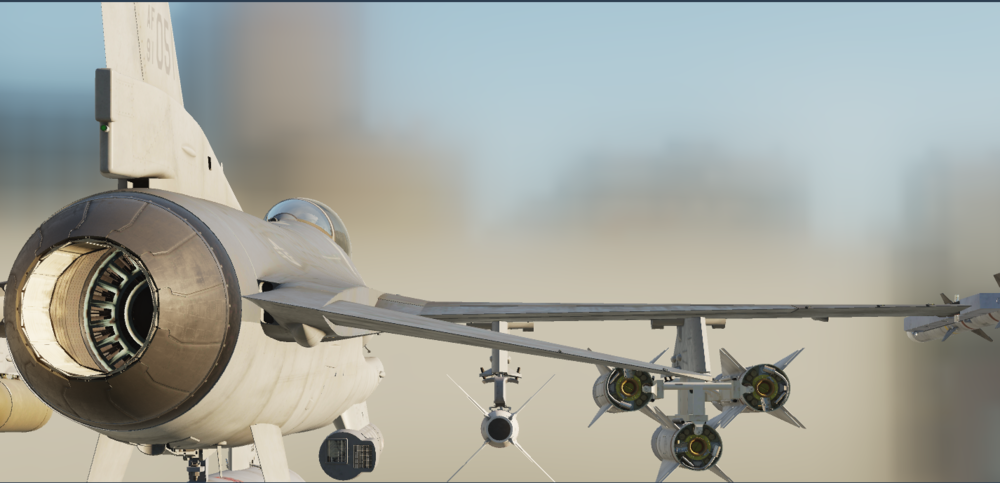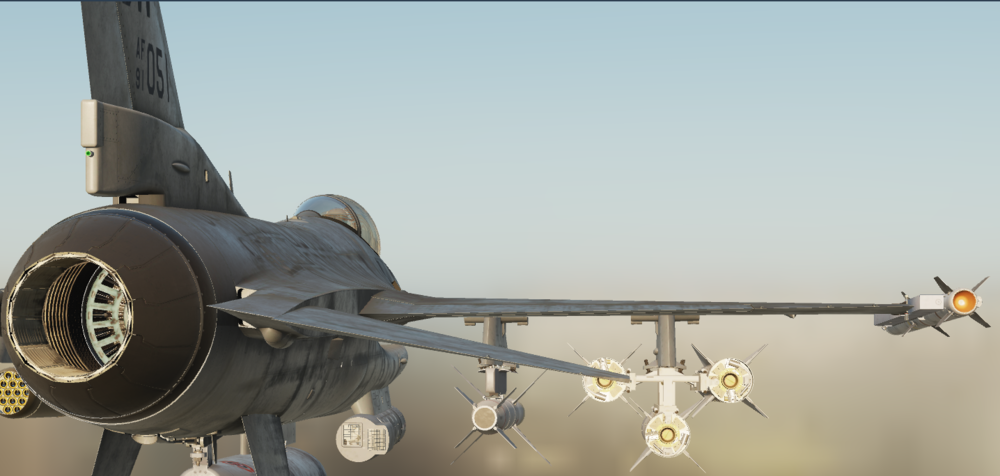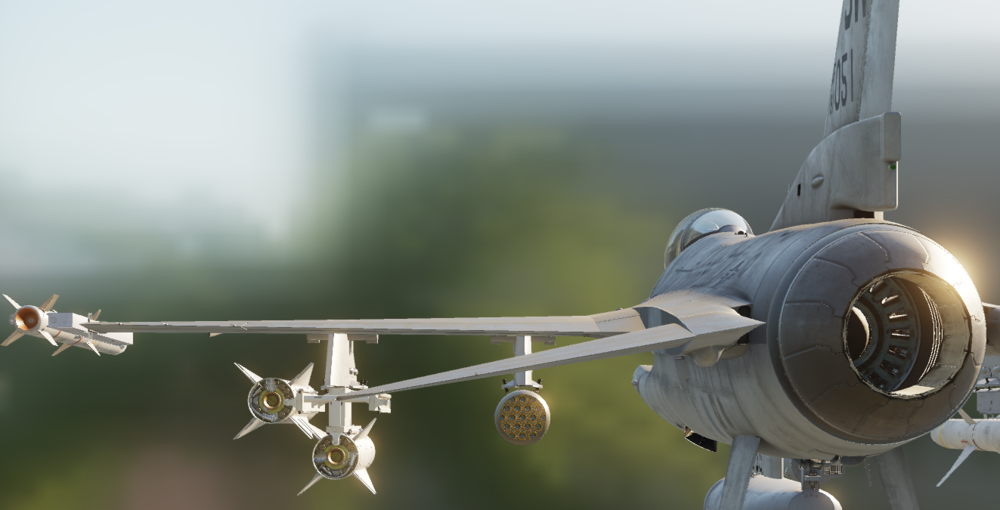

Xavven
Members-
Posts
472 -
Joined
-
Last visited
-
Days Won
1
Recent Profile Visitors
The recent visitors block is disabled and is not being shown to other users.
-
Touchdown on the rear gear and hold the nose at something like 11°-12° until 100 kts, and do not hold the speedbrakes switch aft during the aerobrake. They are automatically retracted slightly from max to avoid hitting the runway, but the pilot holding the speedbrake switch forces them to max, increasing the chance of a strike. Then allow the nose to drop and pull aft fully before the nose touches the ground so it touches gently. Then hold your speedbrakes switch aft fully to further extend the speedbrakes to max and begin applying wheel brake. If I'm not mistaken, you want to switch to full forward stick Think I got that wrong, it's full aft stick to increase down-pressure on the rear wheels which increases traction and improves braking performance and handling. Engage nosewheel steering at what, 60 kts I think?
-
The FLCS is actively worsening recovery in my testing. 1. Induce a spin by climbing at 90 degrees, pulling throttle to idle, then pulling full aft stick with some roll when the plane stalls. Optionally add full rudder in the direction of roll. 2. If the nose isn't below the horizon, hold the MPO switch and rock the nose up and down in time with its natural swing until the nose is below horizon. 3. Once nose-down, ensure idle throttle (should have been this whole time since departing controlled flight) and neutralize all control inputs. 4. For a second, the plane appears to be falling straight down in a nose-down attitude (forward flight) and all you have to do is wait to gain airspeed and recover, however the plane begins a violent nose-down summersault (with fully neutralized stick!). If you use the external F2 view, you can see the tailerons are being commanded full pitch-down even if you're already actively spinning in a pitch-down direction already, worsening the pitch rate! This is very bizarre FLCS behavior. Screenshot taken one second before disaster (started from 40,000 ft and would not recover for the whole way down):
-
Check your flight in the mission editor to confirm the frequency, too. Also, if you can provide a track, that helps with troubleshooting.
-
I haven't practiced this lately, but could you enter coordinates JTAC gives you into a steerpoint and then get eyes on with the HMCS?
-
+1 and also HTS is another conspicuously missing one, but it's been teased in a couple of recent screenshots.
-
In ACM I'm in full afterburner unless in specific circumstances: to avoid going over ~500 knots when already pulling max G in anticipation of a descending turn that I'm beginning at high speed already, which would lead to me going over 500 knots near the bottom of the turn to avoid GLOC if pilot is near it to avoid a 3/9 overshoot when in or near the control zone of the hostile aircraft to avoid ground collision in a descending turn close to the ground when defending an IR guided missile Otherwise, instead of MIL power, consider staying in afterburner and pulling more G. Any dogfighting experts feel free to correct me. I'm always looking for advice and improvement.
- 136 replies
-
- 3
-

-
- bfm
- performance
-
(and 3 more)
Tagged with:
-
I agree with @Wizard_03 Also, the loadouts you have present a very strange situation indeed. You have missiles but your opponent does not? How did you get into a situation where your opponent is in your control zone in the first place, then? They should have taken a sidewinder long before that could happen. At least take those missiles off your rails if you are practicing defensive gun-only BFM.
-
There's a real risk of this just being confirmation of my expectations, so at the risk of public internet embarrassment if my mind is playing tricks, I'm going to go out on a limb and say I think the FM changes this patch are really amazing. I seem to have more G available at higher speeds and medium altitude. Pre-patch at ~10,000 ft I'd be in the 3.5-6.0 G range to sustain airspeed, and now post-patch I'm more like 5.0-7.5 G give or take. Rate fights seem easier. It seems much smoother at lower speeds as well. For example if the hostile reverses the turn and I pull as hard as possible around 350 knots to switch to a 1C fight, there used to be way more shaking and buffeting. Now the F-16 seems really compliant. It just slots itself right where I want it to go. So it seems like a more competent dogfighter compared to before. What does everyone else think?
- 136 replies
-
- 1
-

-
- bfm
- performance
-
(and 3 more)
Tagged with:
-
No worries. We'll have to live with what we've got. Thanks! I think in the end it helps me decide personally whether I will put HARMs on 4 & 6, since in the next patch we will have the option to restrict or allow such a loadout. I don't care how others play DCS. But it's a treat when we get what info we can from SMEs on the ED forums.
-
@Scrape I had to slowly and carefully re-read your post a couple times along with another certain one from 9/28/2020 where you talk about the video line being capped for the inboard stations on that T-connector. Is that what you're referring to when you say it's the show stopper? In other words, you are certain that no US vipers have a 1553 bus or video line to 4 & 6, and that is at odds therefore with whatever proof ED has and cannot share with us? If so, this would mean ED's proof is erroneous. Am I interpreting that correctly? Well, that, or ED's allowing us to decide to allow HARMs on 4 & 6 to simulate a non-USA F-16, which is a whole other can of worms because of the whole "this is an ANG circa 2007" thing. Or maybe it's to end HARMgate because it's a tiresome hill to die on. Haha!
-
It's not too late to add your 2 cents, especially given your background and experience!
-
I don't think we can come to IRL conclusions from DCS screenshots, so take this as you will, but here are some screenshots I took while in the mission editor. As some have pointed out, apparently rockets can have plugs in the engine bells to protect them, and they get blown backwards when the rocket motor fires. Some seem to have more clearance issues than others, just eyeballing it. HARM on station 6 That 3rd Maverick on station 7 Hydra Rockets, LAU-3 on Station 4 Not sure if these have plugs





